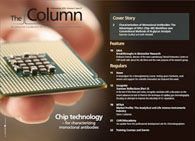Supporting scientific innovation
Waters has launched a programme to support scientific innovation in the fields of health and life science research, food safety and environmental protection.
Waters has launched a programme to support scientific innovation in the fields of health and life science research, food safety and environmental protection. The programme aims to offer research support and assistance to scientists in raising awareness of their ongoing research.
“With the Centers of Innovation Program, we are expanding our emphasis on collaborative relationships with some of the world’s foremost scientific experts,” said Tim Riley, vice president and director of the programme. Among the scientists involved in this programme is Professor Jeremy Nicholson, who works in the field of metabolomic profiling and molecular phenotyping, using the company’s UPLC separation system to characterize and classify the complex molecules produced by the metabolic system.
Also involved is Professor John Engen, who studies the influence of protein conformation on disease and whose past collaborations with Waters has resulted in the development of custom LC instrument, the nanoACQUITY UPLC System with HDX Technology.
Professor James Scrivens is also part of the programme; his group currently uses ion mobility enhanced mass spectrometry in a range of research projects in the biological sciences and has previously collaborated with Waters on the creation of the SYNAPT high definition mass spectrometry system, a shape-selective mass spectrometry instrument.
Additionally, Professor Julie Leary uses Waters equipment to study eukaryotic translation, the process by which messenger RNA is translated into proteins within the human 40S ribosome, to better understand how infectious diseases like hepatitis C and tuberculosis are transferred to humans.
For more information on the programme visit www.waters.com/coi
This story originally appeared in The Column. Click here to view that issue.

New Study Reviews Chromatography Methods for Flavonoid Analysis
April 21st 2025Flavonoids are widely used metabolites that carry out various functions in different industries, such as food and cosmetics. Detecting, separating, and quantifying them in fruit species can be a complicated process.
Analytical Challenges in Measuring Migration from Food Contact Materials
November 2nd 2015Food contact materials contain low molecular weight additives and processing aids which can migrate into foods leading to trace levels of contamination. Food safety is ensured through regulations, comprising compositional controls and migration limits, which present a significant analytical challenge to the food industry to ensure compliance and demonstrate due diligence. Of the various analytical approaches, LC-MS/MS has proved to be an essential tool in monitoring migration of target compounds into foods, and more sophisticated approaches such as LC-high resolution MS (Orbitrap) are being increasingly used for untargeted analysis to monitor non-intentionally added substances. This podcast will provide an overview to this area, illustrated with various applications showing current approaches being employed.

.png&w=3840&q=75)

.png&w=3840&q=75)



.png&w=3840&q=75)



.png&w=3840&q=75)







